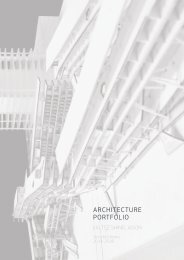Architectural Portfolio 201805
Jason Liu
Jason Liu
- No tags were found...
Create successful ePaper yourself
Turn your PDF publications into a flip-book with our unique Google optimized e-Paper software.
y model 01<br />
model converted the overall<br />
ept of the transforming energy<br />
the lever to the hammer) into<br />
gle (and relatively more metaical)<br />
space. The lever raised the<br />
gy level step by step; the<br />
mer was expressed as a narrow<br />
ing point at the end of the<br />
ow ‘levering’ part, and opened<br />
o a huge space, representing the<br />
resonance.<br />
NG TO MODEL<br />
04<br />
ROOM OF<br />
TRANSFORMATION<br />
DRAWING ROOM<br />
E KEYBOARD<br />
dy model 02<br />
s model translated the rectanguand<br />
repetitive visual language in<br />
keyboard part of the drawing<br />
rd.<br />
s was almost like a wall that<br />
wed people to walk through, and<br />
e were many horizontal and<br />
lar walls within this thick ‘wall’.<br />
ING TO MODEL<br />
KEYBOARD AND THE<br />
SITIONAL PIECE<br />
SITELESS<br />
FALL 2015<br />
By observing the motion of piano action, the<br />
artefact was transformed into drawing. The<br />
drawing was then translated into a spatial<br />
sequence in 3-dimensional space. The<br />
space was finally translated back to a<br />
drawing, concluding the cycle of drawing<br />
and modelling which informed and inspired<br />
each other.<br />
odel 03<br />
odel consisted of two parts. A<br />
ed version of study model 02<br />
d the basis of the keyboard<br />
ut the exterior walls align<br />
e lines on the drawing board.<br />
nsitional piece prepared itself<br />
dging rectangular elements<br />
ore triangular motif of the<br />
rts of the room.<br />
G TO MODEL<br />
DRAWING TO MODEL<br />
ECE<br />
odified,<br />
ion was<br />
plify this<br />
between<br />
e of the<br />
ecreased<br />
THE HAMMER<br />
Study models 06+07<br />
The hammering action was recorded<br />
as a series of stop motion layers. The<br />
concept behind these two models<br />
was similar – capturing the motion<br />
as segments joined together.<br />
DRAWING TO MODEL<br />
Study model 08<br />
This model was a trial of simple<br />
parametric expression, representing<br />
the final ‘resonance’ in an actualised<br />
manner.<br />
The space continuously varied itself<br />
between wide and narrow, which<br />
was an element taken from the<br />
drawing board.<br />
DRAWING TO MODEL<br />
DRAWING TO MODEL<br />
DRAWING TO MODEL<br />
The cross-sections of the models<br />
decreased in size when the space proceeded<br />
forward. The more condensed and<br />
angular space represented the increasing<br />
concentration of mechanical energy of<br />
the hammer.



